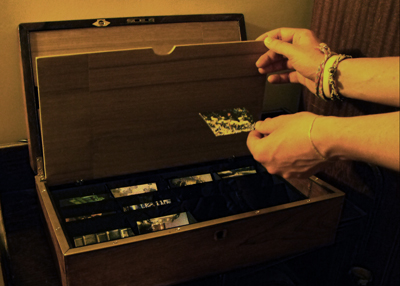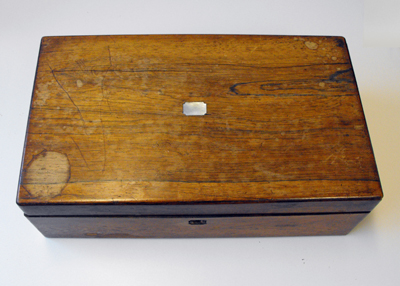April 23, 2014
 PITTSBURGH—The ability of individuals to store and instantly access thousands of their photos online has become a commonplace luxury, but the sheer size of these archives can be intimidating. Researchers at Carnegie Mellon University and Microsoft Research Cambridge, UK, have found people might actually enjoy their collections more by giving up a bit of control and learning to wait.
PITTSBURGH—The ability of individuals to store and instantly access thousands of their photos online has become a commonplace luxury, but the sheer size of these archives can be intimidating. Researchers at Carnegie Mellon University and Microsoft Research Cambridge, UK, have found people might actually enjoy their collections more by giving up a bit of control and learning to wait.
Their 14-month study showed that people reflected more on past events and developed a renewed interest in their online photos when a device called Photobox would randomly print four or five of those photos at varying intervals each month. Though the study involved just a handful of households, the researchers said their findings suggest that, in a world where technology is always on, people sometimes find value in taking it slow.
"We have all these devices — smartphones, touchpads, televisions — that are always competing for our attention," said Will Odom, a Ph.D. student in Carnegie Mellon's Human-Computer Interaction Institute who interned at Microsoft Research, Cambridge. "People who had Photobox in their homes came to appreciate the usefulness of a technology that is in the background."
 Odom and his collaborators, including researchers at the University of Nottingham and Newcastle University, will present their findings April 29 at the CHI Conference on Human Factors in Computing Systems in Toronto.
Odom and his collaborators, including researchers at the University of Nottingham and Newcastle University, will present their findings April 29 at the CHI Conference on Human Factors in Computing Systems in Toronto.
Thanks to ubiquitous cellphone cameras, people today take more photos than ever and online sites such as Flickr allow people to store photos without space constraints. Consequently, many people have amassed gigantic collections. But Odom notes that the size of these collections and the fact that most photos are never made into physical prints often means that people interact very little with these photos. Out of sight, out of mind.
Photobox, which was developed by Microsoft Research Cambridge, is designed to re-engage people with their own photos.
"Rather than allowing these large collections of images to stay hidden away, this device explores the use of serendipity as one approach to delighting people, while also making their images a regular part of their everyday life," said Richard Banks, principal design manager at Microsoft Research Cambridge.
Photobox is a Bluetooth-enabled printer housed inside an antique oak chest. Four or five times each month, it makes 2x3-inch prints of an image randomly selected from the user's Flickr account. Users discover the photos by opening the chest's lid.
"Most technology is all about control," Odom noted. "But in this case, the owner never really knows what photo is going to print or when it is going to print."
A CMU research team — including Jodi Forlizzi and John Zimmerman, both associate professors of human-computer interaction and of design — installed Photoboxes in three households of varying sizes and makeup. For the first few months, most of the users encountered some frustration with this concept of slow technology and indicated they would prefer to speed up the printing process. But after a period of adjustment, "people tended to like it," Odom said.
In one household with several roommates, for instance, the photos became a subject of discussion. "We were all a little curious ... wondering who might be in the next photo," one roommate remarked. "Sometimes we'd all be here and looking at the photos and asking (the Flickr account holder) about them. Like, why one of us was in one but someone else wasn't."
"Overall it's been an interesting experience," agreed the account holder. "We'd never be sitting around my tiny laptop laughing about my photos like we did."
The researchers were surprised to the extent that Photobox led the users to reconsider their relationships with other technology. One person, for instance, decided to take a break from Facebook after the slower pace of Photobox demonstrated that clicking through life was not necessarily the best way to live.
"By subverting people's control over technology and designing it to 'behave' in a much slower way, we opened them up to thinking about technology in their lives and what it might be doing to their relationships," Odom said.
The Human-Computer Interaction Institute is part of Carnegie Mellon's top-ranked School of Computer Science, which is celebrating its 25th year. Follow the school on Twitter @SCSatCMU.
###
Press Release: A Key To Enjoying Massive Online Photo Files May Be Giving Up Some Control, Researchers Say
Carnegie Mellon and Microsoft Research Explore Slow Technology
Contact: Byron Spice / 412-268-9068 / bspice@cs.cmu.edu PITTSBURGH—The ability of individuals to store and instantly access thousands of their photos online has become a commonplace luxury, but the sheer size of these archives can be intimidating. Researchers at Carnegie Mellon University and Microsoft Research Cambridge, UK, have found people might actually enjoy their collections more by giving up a bit of control and learning to wait.
PITTSBURGH—The ability of individuals to store and instantly access thousands of their photos online has become a commonplace luxury, but the sheer size of these archives can be intimidating. Researchers at Carnegie Mellon University and Microsoft Research Cambridge, UK, have found people might actually enjoy their collections more by giving up a bit of control and learning to wait.Their 14-month study showed that people reflected more on past events and developed a renewed interest in their online photos when a device called Photobox would randomly print four or five of those photos at varying intervals each month. Though the study involved just a handful of households, the researchers said their findings suggest that, in a world where technology is always on, people sometimes find value in taking it slow.
"We have all these devices — smartphones, touchpads, televisions — that are always competing for our attention," said Will Odom, a Ph.D. student in Carnegie Mellon's Human-Computer Interaction Institute who interned at Microsoft Research, Cambridge. "People who had Photobox in their homes came to appreciate the usefulness of a technology that is in the background."
 Odom and his collaborators, including researchers at the University of Nottingham and Newcastle University, will present their findings April 29 at the CHI Conference on Human Factors in Computing Systems in Toronto.
Odom and his collaborators, including researchers at the University of Nottingham and Newcastle University, will present their findings April 29 at the CHI Conference on Human Factors in Computing Systems in Toronto.Thanks to ubiquitous cellphone cameras, people today take more photos than ever and online sites such as Flickr allow people to store photos without space constraints. Consequently, many people have amassed gigantic collections. But Odom notes that the size of these collections and the fact that most photos are never made into physical prints often means that people interact very little with these photos. Out of sight, out of mind.
Photobox, which was developed by Microsoft Research Cambridge, is designed to re-engage people with their own photos.
"Rather than allowing these large collections of images to stay hidden away, this device explores the use of serendipity as one approach to delighting people, while also making their images a regular part of their everyday life," said Richard Banks, principal design manager at Microsoft Research Cambridge.
Photobox is a Bluetooth-enabled printer housed inside an antique oak chest. Four or five times each month, it makes 2x3-inch prints of an image randomly selected from the user's Flickr account. Users discover the photos by opening the chest's lid.
"Most technology is all about control," Odom noted. "But in this case, the owner never really knows what photo is going to print or when it is going to print."
A CMU research team — including Jodi Forlizzi and John Zimmerman, both associate professors of human-computer interaction and of design — installed Photoboxes in three households of varying sizes and makeup. For the first few months, most of the users encountered some frustration with this concept of slow technology and indicated they would prefer to speed up the printing process. But after a period of adjustment, "people tended to like it," Odom said.
In one household with several roommates, for instance, the photos became a subject of discussion. "We were all a little curious ... wondering who might be in the next photo," one roommate remarked. "Sometimes we'd all be here and looking at the photos and asking (the Flickr account holder) about them. Like, why one of us was in one but someone else wasn't."
"Overall it's been an interesting experience," agreed the account holder. "We'd never be sitting around my tiny laptop laughing about my photos like we did."
The researchers were surprised to the extent that Photobox led the users to reconsider their relationships with other technology. One person, for instance, decided to take a break from Facebook after the slower pace of Photobox demonstrated that clicking through life was not necessarily the best way to live.
"By subverting people's control over technology and designing it to 'behave' in a much slower way, we opened them up to thinking about technology in their lives and what it might be doing to their relationships," Odom said.
The Human-Computer Interaction Institute is part of Carnegie Mellon's top-ranked School of Computer Science, which is celebrating its 25th year. Follow the school on Twitter @SCSatCMU.
###